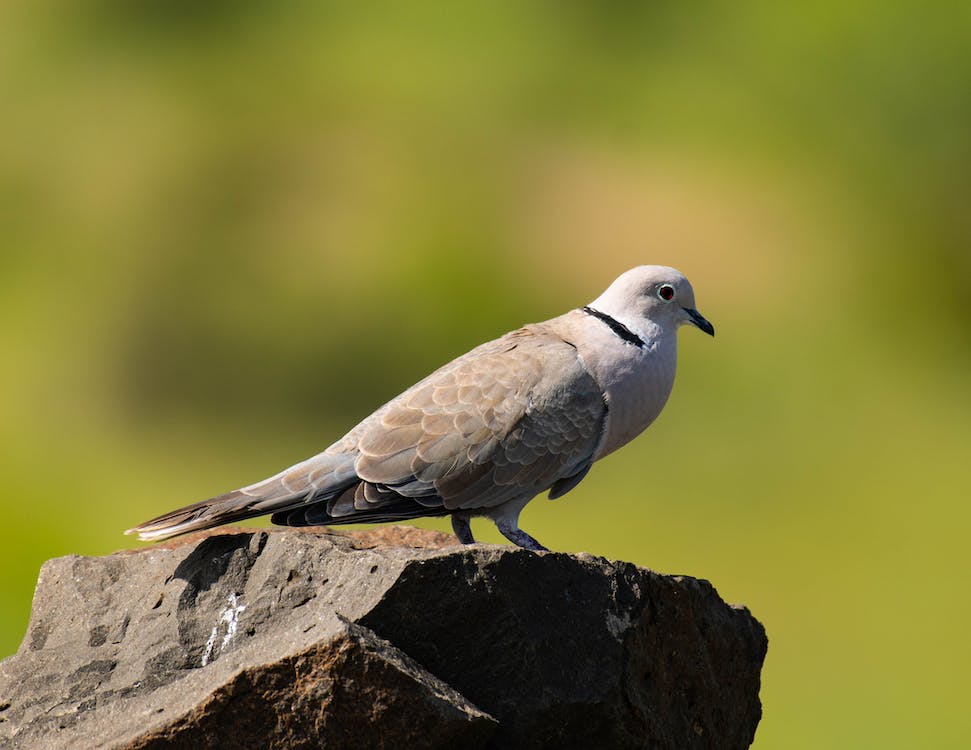It is a large dove common in farmland and cities around the world. Wild counterparts often thrive on cliffs, while the feral groups have quickly adjusted nesting on infrastructures, such as bridges and skyscrapers. Both domestic and feral birds come in color varieties, ranging from gray to white, orangey-brown, and black.
Read further to know more about the Rock Pigeon.
What is a Rock Pigeon?
Rock Pigeon (Columba livia) common pigeon, or rock down, is a bird belonging to the Columbidae family. In layman terms, there are commonly referred to as “pigeons.” The domestic counterpart descended from the species, with the escaped domestic pigeons, resulting in the surge of feral population size in many parts of the world.
Its seven levels of classification are as follows:
Kingdom: Animalia
Phylum: Chordata
Class: Aves
Order: Columbiformes
Family: Columbidae
Genus: Columba
Species: C. livia
Rock Pigeon Physical Description
Rock pigeons are stout birds with pointed wings, rounded tail, and small reddish, pinkish, to grayish-black legs and feet. These birds can grow 11-13 inches in length or 27 to 33 centimeters, weigh around 238–380 grams, and have a wingspan of 20 to 26 inches or 50 to 66 centimeters. Their eyes are round, circled with skin. Bill is small with a fleshy covering at its base. They come in a variety of colors, often with a bluish-gray body, white rump, and pale gray wings. Both sexes look similar, but males are relatively larger.
Where can they be spotted?
Rock Pigeons are widely spread throughout the world, from Canada to Alaska, the United States, Central, America, Europe, Africa, and Asia. Wild groups often nest on rocky cliffs, near vegetation or agricultural lands. Rural birds live in farm buildings while skyscrapers serve as a refuge for those located in cities.
Interesting Facts You Should Know About the Rock Pigeon
Rock pigeons primarily eat a variety of seeds. However, it may also consume insects and plants. They peck food items off the ground and use their bill for drinking water, functioning like a straw. They aggregate when feeding, often walking or running as their peck food. When they feel threatened, the flock will fly together, and circle the area a few times before deciding to come back on the ground.
These birds are gregarious and will normally feed during the morning up until the mid-afternoon. Rock pigeons also flock when roosting or sunning. They walk or run with their heads bobbing forward and backwards. In flight, they often follow a linear and steady path. While its homing breed cousins are known to find their way home and travel long distances, rock pigeons are generally sedentary and will rarely move from its area.
Rock pigeons are monogamous and will form life-long bonds with their partners. A pair may develop any time throughout the year and will work hand-in-hand when it comes to parenting. The male rock pigeon will collect nesting materials such as twigs and grass, while the female builds the nest on beams, ledges, and other covered flat surfaces. These birds will reuse the same nest but will do adequate repairs for the next chicks.
A rock pigeon pair may produce over five broods annually with two eggs laid on one breeding season. Parents jointly incubate the eggs for about 16 to 19 days, feeding them with pigeon milk. Broods will be able to leave their nest in about four weeks.
Rock pigeon’s population size is estimated to be around 260 million individuals. While their number is decreasing, they are classified as Least Concern (LC) under the IUCN Red List.
WILDLIFE PARKS AND RESERVES WHERE THIS SPECIES IS FOUND:
SOUTH AFRICA
Kalahari Gemsbok National Park
NAMIBIA
BOTSWANA
BOTSWANA BIRDS | SOUTH AFRICA BIRDS
NAMIBIA BIRDS | ZAMBIA BIRDS | ZIMBABWE BIRDS

